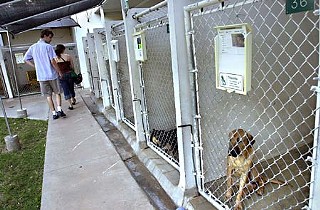How They're Doing It
On the road to no-kill
By Patricia J. Ruland, Fri., April 3, 2009
"I definitely believe progress is being made. Of course, I would like it to be faster. Wouldn't we all?" – Dr. Ellen Jefferson, founder of Emancipet and now president of Austin Pets Alive!
At present, according to city officials, the euthanasia rate at the Town Lake Animal Center is down to 29% of total intake. Mission: Orange partnership data for the first quarter of 2009 should be available this week, and Mission: Orange coordinator Karen Medicus expects more good news. According to Ed Sayres, national American Society for the Prevention of Cruelty to Animals president and architect of the Mission program, the goal for the humane community in general is to achieve steady, sustainable progress. It appears that Austin is meeting that objective.
No one denies there's more work to be done. The center's critics, citing the No Kill Equation program, call for: a feral cat trap-neuter-release program; more high-volume, low-cost spay/neuter programs; more rescue groups; expanded foster care; comprehensive adoption programs; pet retention; medical and behavior rehabilitation; public relations/community involvement; and more recruitment of volunteers. What mystifies the shelter system and its defenders is that the city is already doing all these things and steadily expanding their range and effect. If the center's and partnerships' efforts are to be dismissed as ineffectual, shouldn't these very measures be deemed ineffectual as well, asked TLAC Program Manager Amber Rowland. "Maybe there's some proprietary secret [critics are] not sharing," she said.
The various life-saving methods, and more generally compassion toward companion animals, are in fact indicative of an intensive, multifaceted humane movement in the United States, which has had remarkable success. According to Rich Avanzino, father of the no-kill movement, the drop in animals killed over recent decades has been dramatic. In 2007, Avanzino told a reporter: "Forty years ago, 23 million dogs and cats were being killed in shelters. Twenty years ago, that number was 17 million. This year it's 3.7 million." That's quite a collective national accomplishment.
Any city wanting to save lives must tackle the daunting problem of animal homelessness (likely to spike as the economy plunges) on two fronts: prevention (which reduces intake) and placement (which increases the live-release rate of animals). The past 10 years, since Austin officially adopted a no-kill goal, have paved the way for the city's recent improving numbers. Emancipet Executive Director Amy Mills says the system's spay/neuter programs "have provided more than 181,000 free or low-cost surgeries in Austin since 1997. It helps put in perspective the number of surgeries needed to make a difference over time." Austin has also done a better job of getting animals out of the shelter. "The Austin Humane Society transfers as many animals as possible from the city of Austin's Town Lake Animal Center and continues to increase transfers year over year," said Austin Humane Society Executive Director Frances Jonon. "In 2008, AHS transferred over 1,100 cats and dogs from TLAC, an increase of 48% over the last three years."
Another hallmark of Austin's partnership model is its cultivation of a wide network of rescue groups. In the past year, Austin Pets Alive! has focused directly on placing animals otherwise slated for euthanasia, with profound success. Jefferson outlined her group's contribution to reducing Austin's kill rates – pulling about 1,000 animals at press time – in this way: "We use multiple adoption sites to place our animals. We are trying to network back into the community from which these animals came. The community can help us by getting involved in donating to our new facility, volunteering, and fostering animals in need." She added that a recent donation will permit Austin Pets Alive! to save "an additional 500 lives in the next 12 months."
Generally, city personnel credit the partnership model for getting the community fully engaged in giving homeless animals a better chance of surviving. But generalities don't do full justice to the city's extensive and community-customized efforts. Here are just a few of the specific partnership programs that have proven effective at saving animal lives:
• Increased cat and kitten adoptions via targeted summer programs and reduced fees;
• A network of more than 170 foster homes for underage and sick/injured animals;
• Austin Humane Society feral-cat coordinator, with more than 200 area volunteer trappers (5,000 trap/neuter/returns per year);
• Free microchip implants in high-intake neighborhoods (to improve recovery rate);
• Free or low-cost wellness services (Animal Trustees of Austin, Emancipet);
• Austin Humane Society's Behavior, Re-Homing, Assessment and Training Team, aka BRATT (behavioral rehabilitation);
• Pit Bull Task Force, reducing intake of pit-bull-type breeds while increasing public safety;
• ASPCA educational programs for schoolchildren, in collaboration with Austin Independent School District.
Got something to say on the subject? Send a letter to the editor.











